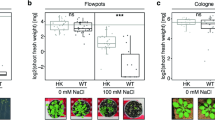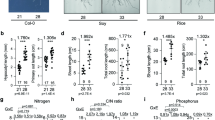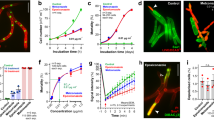Abstract
PHENOLIC compounds and their glycosides are widespread in plants. They have uncertain metabolic roles, although they are regarded as metabolic by-products conferring resistance to pathogens1,2. Phloridzin, the 2′-glucoside of phloretic acid, for example, is unique to species of Malus and is the major phenolic compound of commercial apple trees (Malus pumila Mill), representing 3–7% of the dry weight of leaves as well as occurring in bark and roots3. It is not involved in resistance to apple scab as formerly supposed4, but affects the metabolism of many organisms. It inhibits growth of wheat coleoptiles5 and tomato roots6 but more than doubles photosynthetic rates in Elodea7,8. In animals it inhibits the utilisation of carbohydrates9, and one of the degradation products4,10 of phloridzin, phloroglucinol, acts synergistically with auxin to promote growth of oat mesocotyls11. There have been indications that phloridzin, and phloroglucinol, promote the expansion of apple leaves12 and the rooting of apple shoots13, respectively. This suggests that phloridzin may have important effects on Malus. I have now shown that phloridzin promotes the growth of cultured apple shoots. The effect is pronounced and has practical application.
This is a preview of subscription content, access via your institution
Access options
Subscribe to this journal
Receive 51 print issues and online access
$199.00 per year
only $3.90 per issue
Buy this article
- Purchase on Springer Link
- Instant access to full article PDF
Prices may be subject to local taxes which are calculated during checkout
Similar content being viewed by others
References
Levine, D. A., Am. Nat., 105, No. 942, 157–181 (1971).
Towers, G. H. N., Biochemistry of Phenolic Compounds (edit. by Harborne, J. B.), 250 (Academic, London and New York, 1964).
Williams, A. H., Nature, 202, 824 (1964).
Hunter, L. D., Phytochemistry, 14, 1519 (1975).
Hancock, C. R., Barlow, H. W. B., and Lacey, H. J., J. exp. Bot., 12, 401 (1961).
Street, H. E., and Lowe, J., Ann. Bot., Lond. N. S., 14, 307 (1950).
Marrè, E., Boll. Soc. ital. Biol. sper., 26, 1299 (1950).
Marrè, E., and Servattaz, O., Nuova G. bot. ital. N. S., 62, (1955).
Shapiro, B., Biochem. J., XIi, 151 (1974).
Grochowska, Maria, J., Plant Physiol., Lancaster, 41, No. 3, 432 (1966).
Nitsch, J. P., and Nitsch, C., Ann. Physiol. Vég., 4, 211 (1962).
Jones, O. P., and Obrenović, Snezana, Rep. E. Mailing Res. Stn 1975, 67 (1976).
Jones, O. P., and Hatfield, S. G. S., J. hort. Sci. (in the press).
Jones, O. P., J. hort. Sci., 48, 181 (1973).
Quoirin, M., Bull. Rech. Agron, Gembloux 9(2), 189 (1974).
Wetmore, R. H., and Sorokin, S., J. Arnold Arbor., 36, 305 (1955).
Abbott, A. J., and Whiteley, E., Scientia Hort., 4, 183 (1976).
Patent applied for, Patent application no. 29730/76.
Author information
Authors and Affiliations
Rights and permissions
About this article
Cite this article
JONES, O. Effect of phloridzin and phloroglucinol on apple shoots. Nature 262, 392–393 (1976). https://doi.org/10.1038/262392a0
Received:
Accepted:
Published:
Issue Date:
DOI: https://doi.org/10.1038/262392a0
This article is cited by
-
Adventitious rooting of Jatropha curcas L. is stimulated by phloroglucinol and by red LED light
In Vitro Cellular & Developmental Biology - Plant (2013)
-
Effect and analysis of phenolic compounds during somatic embryogenesis induction in Feijoa sellowiana Berg
Protoplasma (2008)
-
Production of multiple shoots and plant regeneration from leaf segments of fig tree (Ficus carica L.)
Journal of Plant Biology (2007)
-
Promotion by phloroglucinol of adventitious root formation in micropropagated shoots of adult wild cherry (Prunus avium L.)
Plant Growth Regulation (1994)
Comments
By submitting a comment you agree to abide by our Terms and Community Guidelines. If you find something abusive or that does not comply with our terms or guidelines please flag it as inappropriate.



